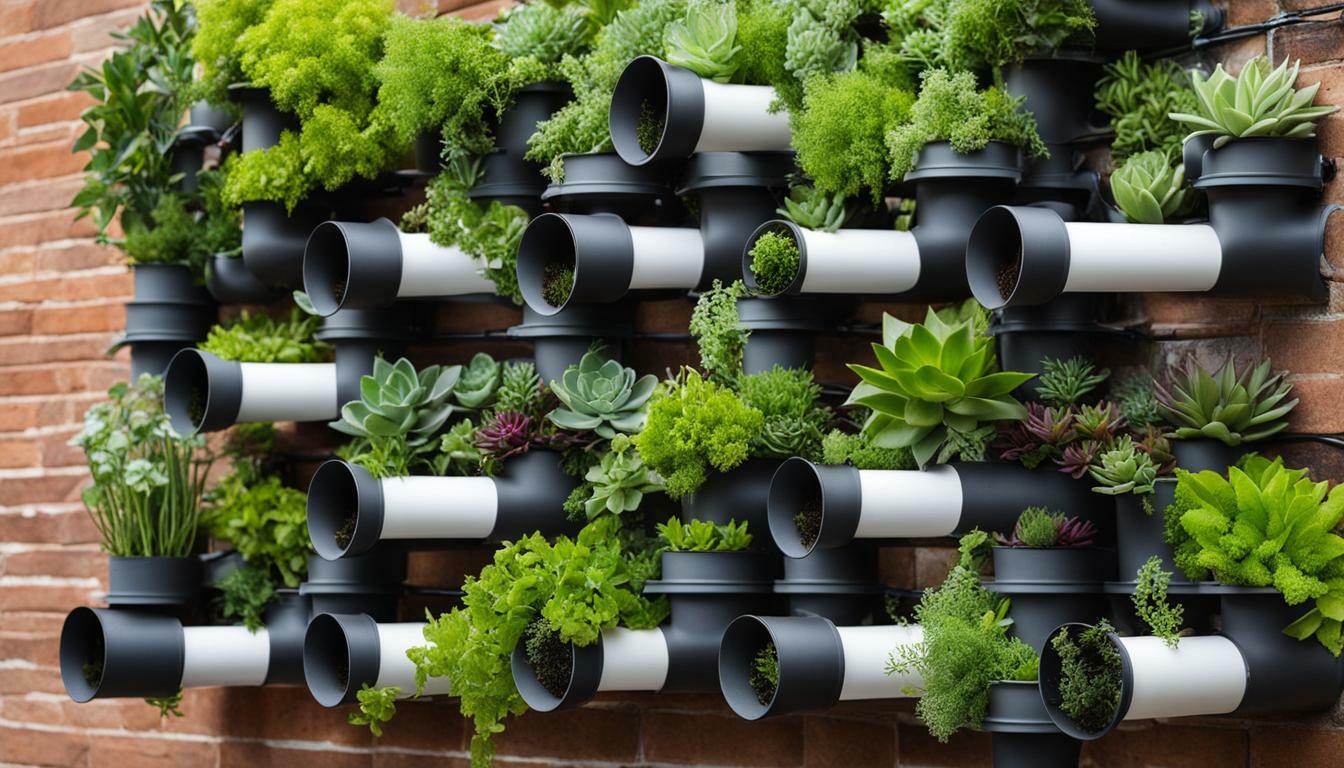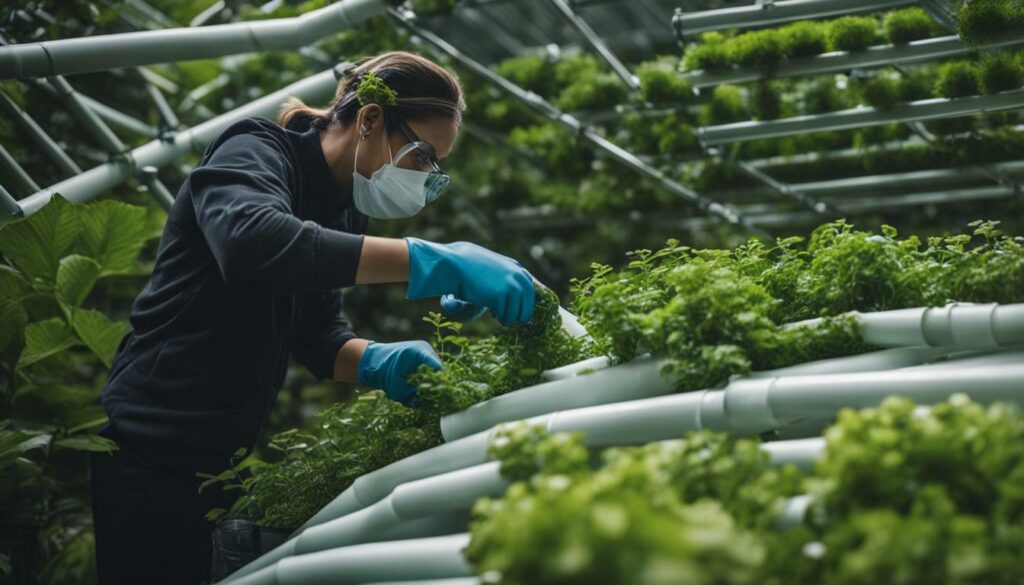Welcome to our comprehensive guide on DIY vertical garden PVC projects. Whether you have limited space or simply want to add a unique and sustainable touch to your home or garden, this guide will help you unleash your creativity and create stunning vertical garden displays.
Key Takeaways:
- DIY vertical garden PVC projects are a great way to maximize space and create visually appealing displays.
- Using recycled PVC pipe is a sustainable option for building your vertical garden structure.
- You will need a variety of materials and tools, such as PVC pipes, potting soil, and a drill, to complete your DIY vertical garden.
- Step-by-step instructions will guide you through the process of building and maintaining your DIY vertical garden PVC structure.
- There are various plants that thrive in vertical gardens, such as greens, herbs, and strawberries.
- While PVC can be used for gardening, it’s important to consider safety precautions and alternative options.
- If DIY is not your style, there are ready-made vertical garden solutions available for purchase.
Benefits of DIY Vertical Garden PVC Projects
DIY vertical garden PVC projects offer a multitude of benefits that go beyond just aesthetics. Let’s explore some of the reasons why you should consider embarking on your own vertical garden journey.
First and foremost, DIY vertical garden PVC projects allow you to maximize your gardening space, especially if you have limited area in your backyard or balcony. By utilizing vertical space, you can grow more plants in a single square foot than traditional ground-level gardens. This is especially beneficial for urban dwellers who may have limited outdoor space but still want to enjoy the beauty and benefits of gardening.
Another benefit of DIY vertical garden PVC projects is their sustainability aspect. By repurposing PVC pipes, you are reducing waste and giving new life to materials that would otherwise end up in landfills. Additionally, vertical gardening allows for efficient water usage, as water easily flows through the pipes and reaches the roots of each plant, minimizing water wastage.
Furthermore, DIY vertical garden PVC projects provide a visually appealing display. The vertical arrangement of plants adds depth and dimension to your garden, creating a stunning focal point. Whether you choose to grow vibrant flowers, lush foliage, or even edible crops, your vertical garden will be a unique and eye-catching addition to your outdoor or indoor space.
Overall, DIY vertical garden PVC projects offer a practical and sustainable way to beautify your space, maximize your gardening potential, and make a positive impact on the environment. With a little creativity and some basic tools, you can create a stunning vertical garden that will bring joy and a touch of nature to your everyday life.
| Benefits of DIY Vertical Garden PVC Projects | |
|---|---|
| Maximizes gardening space | – Enables growing more plants in a small area |
| Promotes sustainability | – Repurposes PVC pipes and reduces waste |
| Visually appealing | – Adds depth and dimension to the garden |
| – Creates a unique focal point | |
| – Enhances the overall aesthetics of the space |
“DIY vertical garden PVC projects offer a practical and sustainable way to beautify your space, maximize your gardening potential, and make a positive impact on the environment.”
Materials and Tools Needed for DIY Vertical Garden PVC Projects
Before you begin your DIY vertical garden PVC project, it’s essential to gather the necessary materials and tools. Here’s a comprehensive list to ensure you have everything you need to get started:
- PVC pipe – 6-to-8-inch diameter by 4 ft. long
- PVC pipe – 1½-to-2-inch diameter by 4 ft. long
- Potting soil
- 16 Pieces Recycled cardboard, roughly 2-inch square
- 17 Seedlings of lettuce and mixed greens
- Cordless or electric drill
- 1-1/2 inch Hole saw for drill
- ¼ inch Drill bit
- Pencil
- Tape measure
Now that you have gathered all the necessary materials and tools, it’s time to start building your DIY vertical garden PVC structure.
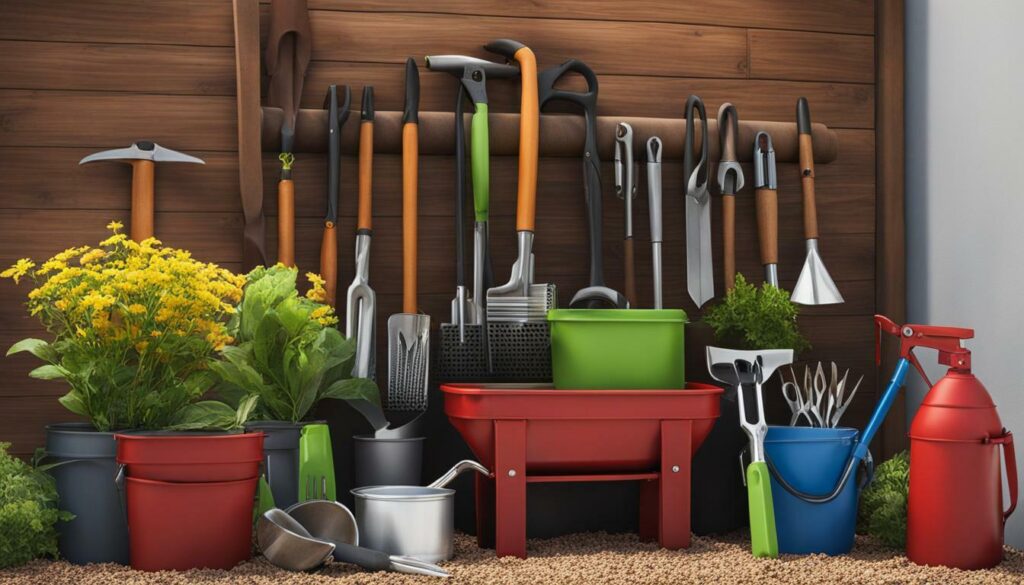
To build the structure, begin by marking four evenly spaced lines vertically down the large PVC pipe. These lines will serve as guides for the holes you’ll drill. Measure 12 inches from one end and mark a line around the circumference of the pipe, labeling this end as “DOWN” for assembly purposes.
Using the hole saw, drill one hole where a vertical line intersects with a horizontal line. Drill a second hole directly opposite, at the intersection of a vertical and horizontal line. Repeat this process to create two lines of four drilled holes each. Then, drill three more holes along each remaining vertical line, offsetting each new hole so that it’s placed diagonally from those adjacent to it.
Once the holes are drilled, it’s important to smooth out any rough edges using a metal file. To prep the irrigation pipe, use a 3/16-inch drill bit to bore holes throughout the 3/4-inch PVC pipe. Next, wrap the 3/4-inch pipe with weed block material and secure it in place with zip ties. Add PVC caps on both ends of the pipe to complete the structure.
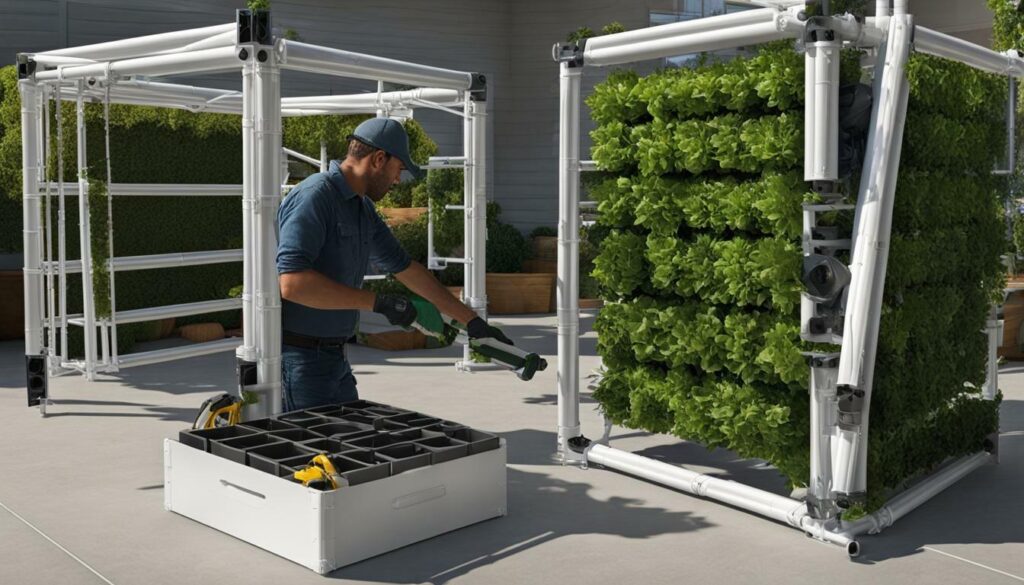
Now that your DIY vertical garden PVC structure is complete, you can start planting. Use cardboard squares as temporary plant holders to keep the soil in place while the seedlings develop a root system. Slide a seedling into each hole, using the cardboard as a funnel to guide it into place. Be careful not to damage the seedlings as you maneuver them into position. Continue planting until all the holes are filled.
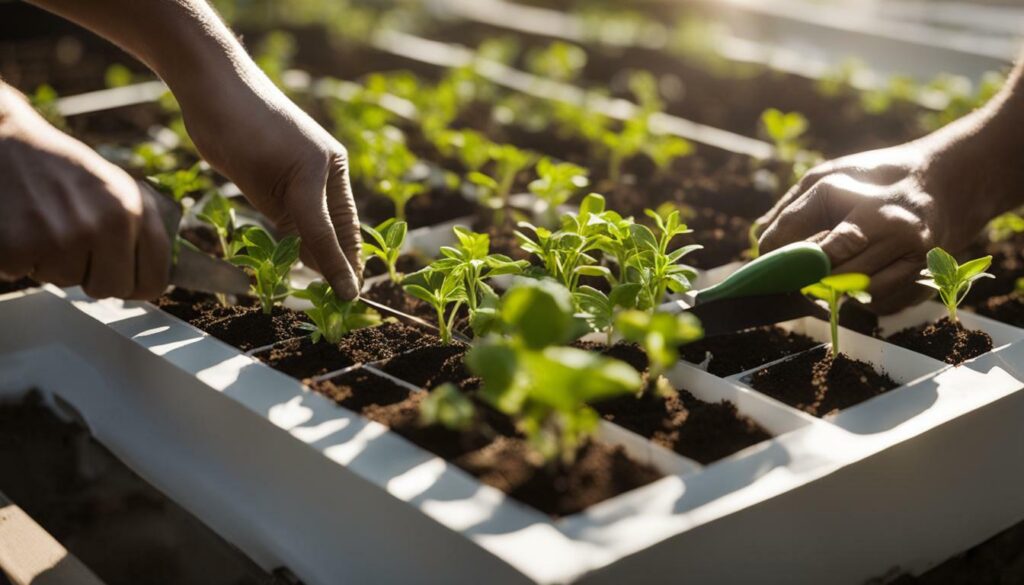
Water the tower slowly from the top, as well as into the 2-inch pipe, to ensure proper hydration for your plants. Take care of your DIY vertical garden PVC by regularly maintaining and monitoring the growth of your plants.
With these materials and tools, you have everything you need to build and plant your own DIY vertical garden PVC project. Enjoy the process of creating a unique and space-saving garden that will add beauty and greenery to your home or outdoor space.
Building the DIY Vertical Garden PVC Structure
Now that you have all the materials and tools ready, let’s dive into the process of building your DIY vertical garden PVC structure. Follow these step-by-step instructions to create a sturdy and functional tower garden.
1. Start by measuring and cutting your PVC pipes. Secure both the 6-to-8-inch diameter pipe and the 1½-to-2-inch diameter pipe to your work surface using bar clamps. Use a hacksaw or reciprocating saw to cut the pipes to the desired size. This will depend on the height you want for your vertical garden.
2. After cutting the pipes, it’s time to drill the planting holes. For the larger PVC pipe, mark planting holes about 6-8 inches apart using a white or silver marker. Then, use a drill with a 1-3/4-inch hole saw bit to punch out the holes. Make sure to smooth out any rough edges using a metal file.
3. Next, you’ll need to add drainage holes to the smaller PVC pipe. Use a 3/16-inch drill bit to bore holes throughout the 3/4-inch pipe. This will ensure proper drainage for your plants.
4. Now it’s time to assemble the tower. Place the large pipe in the center of your planter or garden bed and slip the irrigation pipe inside the large one. Add about six inches of gravel to anchor the irrigation pipe and keep it centered. You can also secure the large pipe in place by filling the planter halfway with stones or gravel.
5. Fill the large pipe with potting soil, making sure to reach the bottom of the lowest holes. Keep the irrigation pipe centered as you scoop soil into the larger pipe. The potting soil will provide the necessary nutrients for your plants to thrive.
6. To plant your seedlings, fold a piece of cardboard into a V shape and set it inside each hole. This will act as a temporary method to hold the soil in place while the seedlings develop a root system. Gently place a seedling into each hole, using the cardboard as a funnel. Be careful not to damage the seedlings as you position them. Continue filling the holes with soil until each one is planted.
7. Finally, water your vertical garden slowly from the top, allowing the water to seep down into the irrigation pipe. This will ensure that all the plants receive adequate moisture.
With these steps, you have successfully built your DIY vertical garden PVC structure. Now you can enjoy the benefits of vertical gardening and create a beautiful and space-efficient display of plants in your home or outdoor space.
| Materials | Tools |
|---|---|
| PVC pipe – 6-to-8-inch diameter by 4 ft. long | Cordless or electric drill |
| PVC pipe – 1½-to-2-inch diameter by 4 ft. long | 1-1/2 inch Hole saw for drill |
| Potting soil | ¼ inch Drill bit |
| 16 Pieces Recycled cardboard, roughly 2-inch square | Pencil |
| 17 Seedlings of lettuce and mixed greens | Tape measure |
Planting and Maintaining Your DIY Vertical Garden PVC
Once your DIY vertical garden PVC structure is complete, it’s time to bring it to life by planting your favorite plants. Follow these tips for successful planting and maintenance of your vertical garden.When it comes to planting in your vertical garden PVC, using cardboard as a temporary method of holding the soil in place is highly recommended. This helps prevent the soil from washing away every time you water your plants. Simply fold each cardboard square slightly and use it as a funnel to set the seedlings in place. Gently push the cardboard into the hole, being careful not to damage the seedling.
While it is important to be mindful of the placement of the holes during the construction of your PVC tower, it doesn’t have to be perfect. You have some flexibility in the positioning of the holes as you make your vertical garden PVC. This gives you room to experiment and adjust as needed.
The types of plants that thrive in a vertical garden PVC are small plants, such as various greens like lettuce, bok choy, and kale, as well as herbs. Strawberries are also a great option for vertical growth in your PVC tower garden, as it keeps them off the ground and out of the reach of pests.
Choosing the Right Plants
When selecting plants for your DIY vertical garden PVC, consider their growth habits and sunlight requirements. Make sure to choose plants that are suited for vertical growth and can withstand the conditions of your specific location. Greens and herbs are generally good options, but it’s always a good idea to do some research or consult with a local garden expert for plant recommendations in your area.
Regular maintenance is key to maintaining the health and beauty of your vertical garden PVC. Water your plants regularly, making sure to water the tower slowly from the top as well as into the 2-inch pipe to ensure adequate moisture reaches the roots. Depending on the plants you choose, fertilizing and pruning may also be necessary to promote healthy growth.
Keep an eye out for any pests or diseases that may affect your plants and take appropriate measures to control them. Regularly inspect the PVC structure for any signs of damage or wear and tear, and make any necessary repairs or adjustments as needed to ensure the longevity of your vertical garden PVC.
| Materials | Tools |
|---|---|
| PVC pipe – 6-to-8-inch diameter by 4 ft. long | Cordless or electric drill |
| PVC pipe – 1½-to-2-inch diameter by 4 ft. long | 1-1/2 inch Hole saw for drill |
| Potting soil | ¼ inch Drill bit |
| 16 Pieces Recycled cardboard, roughly 2-inch square | Pencil |
| 17 Seedlings of lettuce and mixed greens | Tape measure |
Instructions:
- Mark four evenly spaced lines vertically down the large pipe. These will serve as guides for the holes you’ll drill.
- Measure 12 inches from one end and mark a line around the circumference of the pipe. For reference, mark this end of the pipe “DOWN” so you’ll remember that this end should go down into the soil when assembling your salad tower.
- Using the hole saw, drill one hole where a vertical line intersects with a horizontal line. Now drill a second hole directly opposite, again at the intersection of a vertical and horizontal line.
- Drill three more holes along the same vertical lines, leaving about 10 inches between holes. You now have two lines of four drilled holes.
- Drill three holes on each of the remaining vertical lines, offsetting each new hole so that it’s placed diagonally from those adjacent to it, making an alternating pattern.
- To use in the garden: Use a shovel to dig a 10-inch deep hole in the ground and bury the bottom end of the pipe almost to the first hole.
- To use on a patio or balcony, drill several holes in the bottom of a 5-gallon bucket or large planter and fill halfway with gravel. Place the pipe on top of the gravel and add soil around the pipe, to the top of the container.
- Drill about 30 randomly placed quarter-inch holes in the 2-inch PVC.
- Place the small PVC pipe inside the larger PVC so that the top of the inner pipe is slightly higher than the outer pipe. (Add a bit of soil inside the 8-inch PVC to elevate the 2-inch pipe if necessary.) Once established, filling this inner pipe with water aids in getting moisture to the roots.
- Fill the large pipe with potting soil up to the bottom of the lowest holes, keeping the inner pipe centered.
- Fold a piece of cardboard into a V and set it inside the hole. Slide a seedling into each of the lowest holes, using the cardboard as a funnel of sorts. Gently push the piece of cardboard into the hole. This helps to prevent potting soil from escaping. Add more soil to reach the next set of holes. Lightly water seedlings in to settle the soil. Continue in this manner until each hole is planted.
- Add a few more plants to the top of the tower.
- Water the tower slowly from the top as well as into the 2-inch pipe.
With proper planting and maintenance, your DIY vertical garden PVC will flourish and provide you with fresh, homegrown produce or a beautiful display of plants. Enjoy the benefits of maximizing your space, promoting sustainability, and creating a visually appealing vertical garden with PVC!
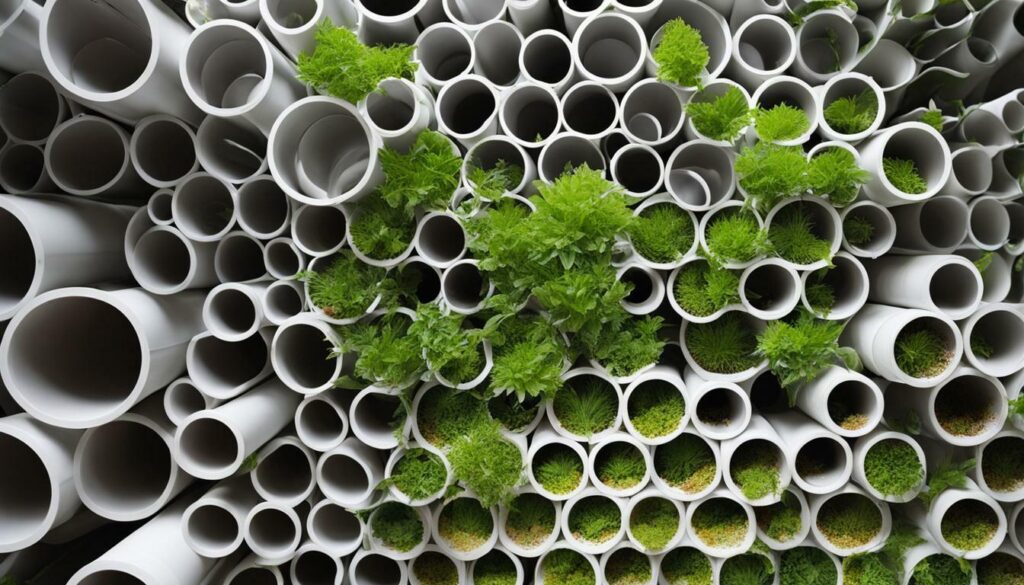
Sources:
- The Spruce

- HGTV

- Architecture Art Designs

What to Grow in Your DIY Vertical Garden PVC
The possibilities are endless when it comes to what you can grow in your DIY vertical garden PVC. Here are some popular options that will flourish in this unique gardening method.
Greens
One of the most popular choices for a vertical garden is to grow different types of greens. Lettuce, spinach, kale, and arugula are all excellent options that can be grown vertically. These leafy greens thrive in smaller spaces and can be harvested continuously by simply picking the outer leaves as needed. With a vertical garden PVC, you can have a constant supply of fresh, nutritious greens right at your fingertips.
Herbs
Herbs are another great choice for a DIY vertical garden PVC. You can grow a variety of herbs such as basil, thyme, rosemary, and mint. These aromatic plants not only add flavor to your dishes but also provide a pleasant fragrance in your garden. With vertical gardening, you can easily access your herbs for cooking, and their upright growth habit helps to save space while adding beauty to your outdoor or indoor space.
Strawberries
If you’re a fan of strawberries, a vertical garden PVC is an excellent way to grow them. Strawberries are well-suited for vertical gardening as their vines can cascade down the sides of the PVC tower. This not only saves space but also prevents the berries from touching the ground, reducing the risk of rotting or pests. Imagine plucking fresh strawberries right from your own vertical garden – it’s a delicious and rewarding experience!
In addition to these popular options, you can also experiment with other suitable crops for your DIY vertical garden PVC. Some suggestions include radishes, cherry tomatoes, peppers, and even small flowers like pansies or marigolds to add a pop of color to your garden. The key is to choose plants that have a compact growth habit, adapt well to vertical growth, and can thrive in the space provided by the PVC structure.
Table 1: Suitable Crops for DIY Vertical Garden PVC
| Crop | Growth Habit | Spacing | Special Considerations |
|---|---|---|---|
| Lettuce | Rosette | 6-8 inches apart | Harvest outer leaves for continuous growth |
| Spinach | Rosette | 6-8 inches apart | Keep soil consistently moist |
| Basil | Upright | 8-12 inches apart | Pinch off flowers to promote leaf growth |
| Strawberries | Vining | 12-18 inches apart | Provide support for vines to cascade |
With these options and the freedom to experiment, your DIY vertical garden PVC can become a thriving oasis of fresh produce and beautiful plants. Get creative, have fun, and enjoy the rewards of growing your own garden in a compact and innovative way.
Safety Considerations and Alternative Options
While PVC has been widely used in DIY vertical garden projects, it’s essential to consider safety aspects and explore alternative options. Let’s explore these considerations to make informed decisions.
When using PVC pipes in gardening, there are concerns about the potential leaching of chemicals into the soil and the subsequent uptake of these chemicals by plants. While there is limited research on the safety of PVC for gardening purposes, it’s recommended to exercise caution, especially if you plan to grow edible plants in your vertical garden.
One alternative option to PVC pipes is to use other types of materials that are considered safer for gardening. For example, you can opt for food-grade plastic containers, stainless steel structures, or even repurposed wooden pallets. These alternatives provide a more natural and eco-friendly choice for vertical gardening.
Another alternative to consider is the use of ready-made vertical garden solutions, which are available in various designs and materials. These solutions eliminate the need for DIY construction and provide a convenient way to create a vertical garden without the use of PVC pipes.
It’s important to weigh the pros and cons of using PVC pipes in your vertical garden and to consider the safety implications. By exploring alternative options and making informed choices, you can create a beautiful and sustainable vertical garden that meets your gardening needs.
Summary:
- PVC pipes may leach chemicals into the soil, raising safety concerns for edible plants.
- Using food-grade plastic containers, stainless steel structures, or repurposed wooden pallets are alternative options for safer vertical gardening.
- Ready-made vertical garden solutions eliminate the need for PVC pipes and offer convenience and variety.
- Considering safety and exploring alternative options ensures a beautiful and sustainable vertical garden.
Table:
| Pros of PVC Pipes in Vertical Gardening | Cons of PVC Pipes in Vertical Gardening |
|---|---|
| – Inexpensive and readily available | – Concerns about chemical leaching |
| – Easy to work with and customize | – Limited research on safety |
| – Durable and long-lasting | – Potential risks for edible plants |
Ready-Made Vertical Garden Solutions
If you love the idea of a vertical garden but don’t have the time or inclination to build your own, there are ready-made options available to meet your needs. Let’s explore some popular solutions.
A popular ready-made solution for a vertical garden is the PVC tower garden. These pre-built structures are designed to maximize space and allow you to grow more than a dozen plants in a single square foot. Made from recycled PVC pipe, these towers are not only durable but also eco-friendly.
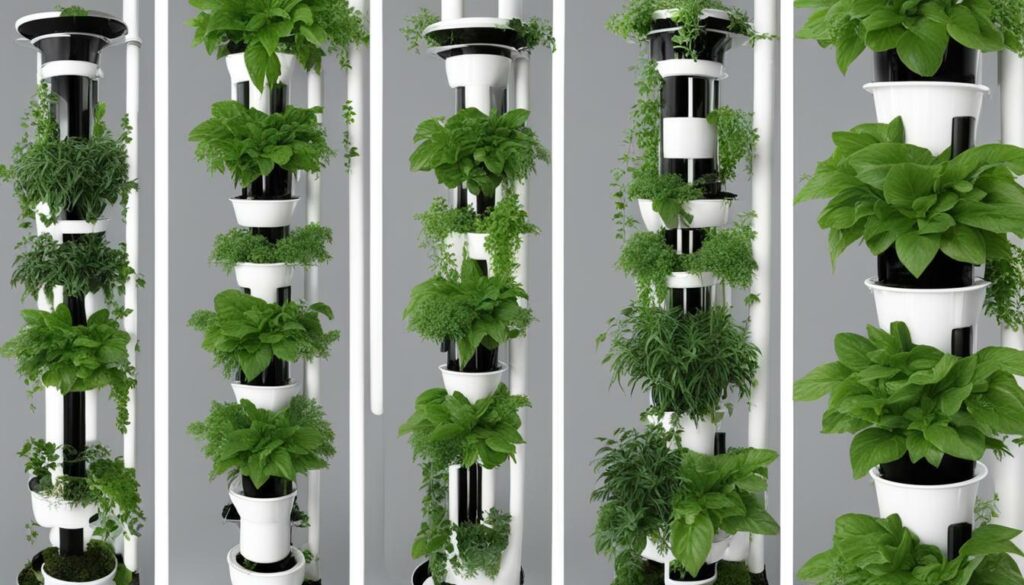
The PVC tower garden is easy to set up and requires minimal maintenance. Simply fill the tower with potting soil, plant your seedlings in the pre-drilled holes, and water them regularly. You can grow a variety of plants in these towers, including greens, herbs, and even strawberries.
Another option for a ready-made vertical garden is the hydroponics system with PVC pipes. This system allows you to grow plants without soil, using nutrient-rich water instead. It’s a great solution for small spaces, as it doesn’t require a large garden bed.
Benefits of Ready-Made Vertical Garden Solutions
- Save time and effort by skipping the DIY process
- Maximize space and grow more plants in a small area
- Eco-friendly options made from recycled materials
- Easy to set up and maintain
- Durable and long-lasting
Whether you choose a PVC tower garden or a hydroponics system, ready-made vertical garden solutions offer a convenient and efficient way to enjoy the benefits of vertical gardening. With these options, you can create a stunning display of plants and enhance the beauty of your outdoor or indoor space.
Ready-made vertical gardens are available in various sizes and designs, allowing you to choose the one that best fits your space and preferences. They are a great addition to any home or garden, bringing nature closer to you and providing fresh produce or beautiful flowers year-round.
| Ready-Made Vertical Garden Solutions | Benefits |
|---|---|
| PVC Tower Garden | Maximizes space and allows for vertical growth |
| Hydroponics System with PVC Pipes | No soil required, efficient use of water and nutrients |
Conclusion
In conclusion, DIY vertical garden PVC projects offer a creative and sustainable way to maximize space and elevate the aesthetic appeal of your home or garden. Whether you choose to build your own structure or opt for a ready-made solution, the possibilities for vertical gardening are endless. With the right materials and tools, you can create a unique and beautiful vertical garden that will not only enhance your living space but also provide a thriving environment for your plants.
One of the key benefits of DIY vertical garden PVC projects is their ability to maximize space. By using vertical structures, you can make the most of limited garden areas or even create a garden in small urban spaces like balconies or patios. This is especially beneficial for those with limited garden space or those who live in apartments or urban areas where traditional gardening may not be feasible.
Another advantage of DIY vertical garden PVC projects is their eco-friendliness and sustainability. By repurposing PVC pipes and other materials, you are contributing to reducing waste and promoting a more sustainable lifestyle. Additionally, vertical gardening can help conserve water as it allows for more efficient irrigation by directing water directly to the plants’ roots.
In terms of aesthetics, DIY vertical garden PVC projects can add a visually appealing display to your outdoor or indoor spaces. With the right choice of plants and proper maintenance, a vertical garden can create a lush and vibrant backdrop, adding a touch of greenery and beauty to any environment.
Whether you are a gardening enthusiast or a beginner looking to explore a new hobby, DIY vertical garden PVC projects are a great way to unleash your creativity and enjoy the benefits of gardening. So why not start your own DIY vertical garden PVC project today and experience the joy of growing your own plants in a unique and innovative way?
Can I Use the Techniques from the Vertical PVC Pipe Garden Creation Guide for Other DIY Projects?
Yes, the techniques from the Vertical PVC Pipe Garden Creation Guide can be adapted for other DIY projects. The same principles of cutting and assembling PVC pipes can be used for creating other vertical structures such as shelving units or organization systems. Flexibility is key in DIY projects.
Are There Different Techniques for Creating a PVC Vertical Garden?
Yes, there are various techniques for creating a PVC vertical garden. You can find step-by-step tutorials online that will guide you through the process of building and installing your own PVC vertical garden. With the right materials and a little bit of know-how, you can have a beautiful and thriving garden in no time.
FAQ
Q: What are the benefits of DIY vertical garden PVC projects?
A: DIY vertical garden PVC projects offer benefits such as maximizing space, promoting sustainability, and providing a visually appealing display.
Q: What materials and tools do I need for DIY vertical garden PVC projects?
A: You will need PVC pipes, potting soil, a drill, hole saw, and other basic tools for DIY vertical garden PVC projects.
Q: How do I build the DIY vertical garden PVC structure?
A: To build the DIY vertical garden PVC structure, you will need to cut the PVC pipes, drill holes, and assemble the tower following step-by-step instructions.
Q: How do I plant and maintain my DIY vertical garden PVC?
A: Planting and maintaining your DIY vertical garden PVC involves using cardboard as temporary plant holders and caring for the plants in the tower.
Q: What can I grow in my DIY vertical garden PVC?
A: You can grow a variety of plants in your DIY vertical garden PVC, such as greens, herbs, and strawberries, depending on your preference.
Q: Are there any safety considerations with using PVC in gardening?
A: There may be safety concerns regarding PVC in gardening, and it’s important to be aware of them. Consider alternative options if you have concerns.
Q: Are there ready-made vertical garden solutions available?
A: Yes, there are ready-made vertical garden solutions available for those who prefer not to undertake a DIY project, such as pre-built PVC tower gardens.

